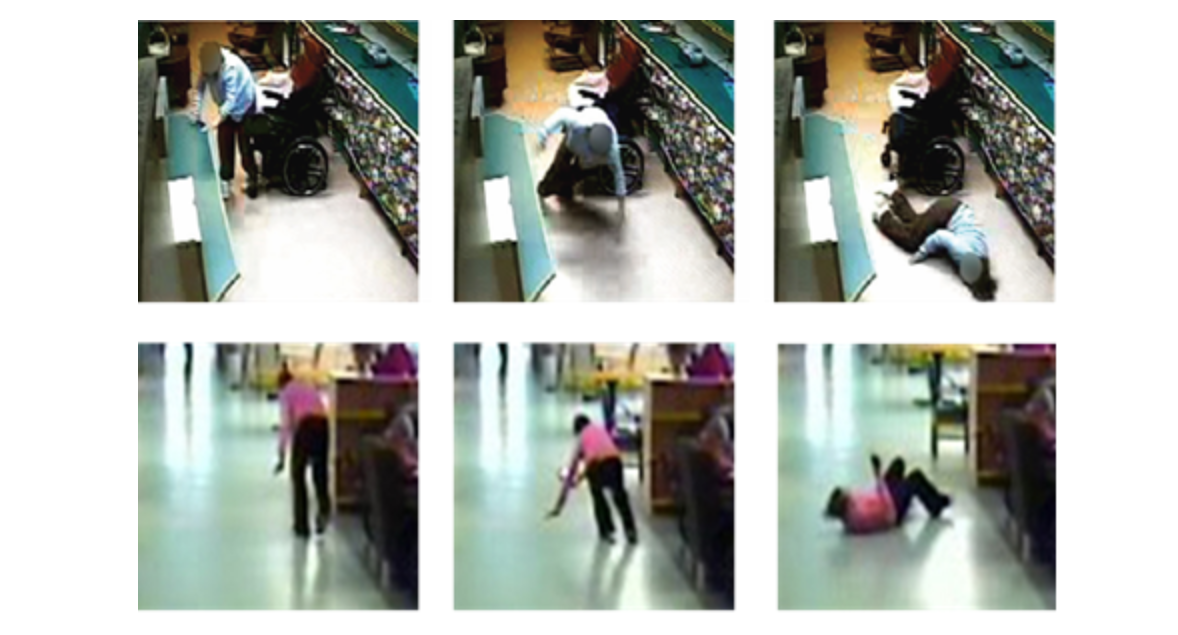More than 60% of traumatic brain injuries (TBI’s) in older adults are caused by falls. The age-adjusted rate of fall-related TBI in older adults has increased three fold over the past few decades. This trend can be partially explained by the increased use of anticoagulants which increases the risk for intracranial bleeding if a person’s head hits the floor. However, any fall that results in head impact can cause TBI. Young adults avoid head impact through protective strategies such as breaking the fall with their arms, turning or flexing their trunk and using their neck muscles. A better understanding of the protective mechanisms used by older adults to avoid head impact during a fall, may lead to improvements in the prevention of TBI.
We collected video footage of 227 falls experienced by 133 residents in two long-term care facilities (see Figure). Each video was analysed to determine whether impact occurred to the head or the hand, the initial direction of the fall and landing configuration, the cause of imbalance, and whether the person was holding anything at the time of falling. Our results showed that head impact occurred in 37% of falls. Falling or landing forward was associated with higher risk of head impact, compared to other directions. Placing hands to break the fall was found in 74% of falls but was not sufficient to prevent head impact. Backward body rotation, which occurred in 36% of sideways falls, did reduce the risk of head impact.

Figure: Real-life falls captured on video in long-term care. (Upper) Example of head impact following unsuccessful attempt to arrest the fall through hand impact. (Lower) Example of avoidance of head impact during a sideways fall, involving rotation during descent to land backwards.
Avoiding head impact during a fall is essential to survival. It is likely that the mechanism to avoid head impact is associated with the development of fall protective responses across the lifespan. Our study showed that forward falls were associated with the highest risk of head impact, despite common use of hands to break the fall. Body rotation during descent was commonly observed and an effective adapted protective mechanism to reduce the risk of head impact. Future research should examine the potential benefit for older adults to engage in exercise programs that train fall protective responses which are important to preventing one of the most severe fall-related injuries – head injury.
Publication
Schonnop, R., Yang, Y. (co-primary author), Feldman, F., Robinson, E., & Robinovitch, S.N.: Prevalence of and Factors Associated with Head Impact during Falls in Older Adults in Long-term Care. Canadian Medical Association Journal (CMAJ), 2013 Nov 19; 185(17): E803-10. http://www.cmaj.ca/content/early/2013/10/07/cmaj.130498
About the Author

Yijian Yang
Centre for Hip Health and Mobility, University of British Columbia
Yijian’s research focuses on injury prevention and mobility enhancement in older adults. His doctoral research sought to understand the circumstances of falls and factors associated with risk for fall-related injuries in older adults in long-term care. His post-doc research involves the evaluation of adapted physical activity programs on mobility enhancement for older adults in assisted living, and evaluation of the patient compliance in acute care in wearing a novel stick-on hip protector for hip fracture prevention. Ultimately, he aims to improve older adults’ health and mobility so that they can live independently with high quality of life.
Copyright
© 2018 by the author. Except as otherwise noted, the ISPGR blog, including its text and figures, is licensed under a Creative Commons Attribution-ShareAlike 4.0 International License. To view a copy of this license, visit https://creativecommons.org/licenses/by-sa/4.0/legalcode.
ISPGR blog (ISSN 2561-4703)
Are you interested in writing a blog post for the ISPGR website? If so, please email the ISGPR Secretariat with the following information:
- First and Last Name
- Institution/Affiliation
- Paper you will be referencing
